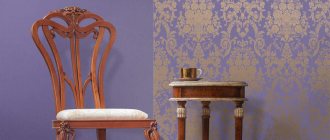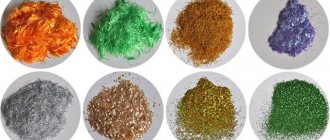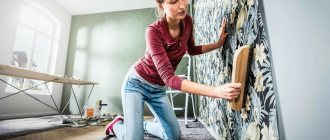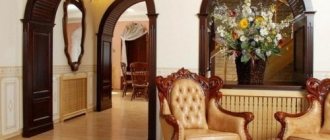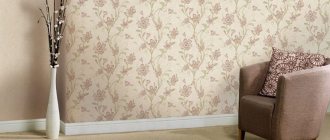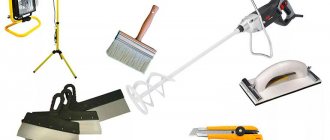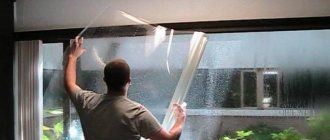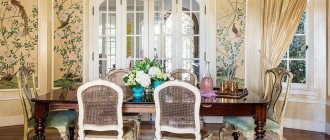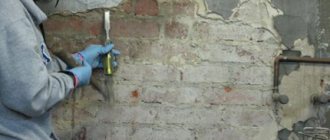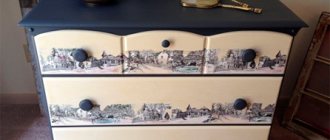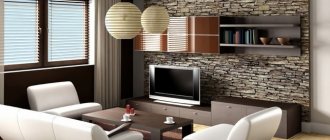Specifics of gluing self-adhesive film
Covering doors with film is a good alternative to replacing them. During use, the surface becomes untidy and requires updating.
Self-adhesive is characterized by the presence of three layers:
- front, representing the external decor of the material;
- adhesive, responsible for attaching the film to the surface;
- protective, performing the corresponding function.
There are various options for decorative self-adhesive - imitation of natural stone, brickwork, leather or fabric. There are also patterns in wood, ceramics or tiles.
Advice! When choosing self-adhesive, you should give preference to single-layer models, since this fabric is stronger and more durable. Two-layer samples consist of a base and a surface, and last much less.
Types of material
Depending on the coating, the film comes in three types:
- polymer (in other words, vinyl), characterized by high strength and aesthetic appearance;
- foil used for pasting hanging furniture;
- paper , used when updating the ends of furniture and low-moving parts.
The surface of the self-adhesive is varied - gloss, holography, mirror, matte or transparent coating, etc. Before choosing, you need to familiarize yourself with the properties of the materials and consider further conditions of use.
Cabinets are often covered with film with pictures of nature Source infomebli.ru
Advantages of self-adhesive
Compared to other raw materials, self-adhesive film is characterized by many positive qualities:
- updating old surfaces - the material eliminates the need to purchase a new set, refreshing the appearance of cabinets and doors;
- protection – additional coating prevents scratches, chips and other damage to the furniture;
- ease of replacement - if the pattern is tired or has lost its aesthetic appearance over time, the film can be easily removed and a new one pasted;
- ease of care - the material does not require any complex manipulations, just wipe it with a damp sponge;
- ease of use - even an untrained person can stick the self-adhesive sticker on a cabinet or door, since all the steps are simple and understandable;
- versatility - the film is suitable for updating furniture in any room, because there are many design options available to choose from;
- budget price - this method of updating old surfaces is the cheapest and costs several hundred rubles.
Attention! The material is resistant to cleaning gels. If kitchen grease has accumulated on the surface, you need to wash the self-adhesive with a cleaning agent. However, metal scrapers cannot be used in this case. This will damage the film.
After treatment with detergent, the surface of the self-adhesive film looks like new Source severdv.ru
Features and types of material
The decision to cover the walls with self-adhesive film must be deliberate. What are the features of such a solution?
- Economical.
- Environmentally friendly. Does not contain harmful chemicals.
- Fire resistance. The components of the composition do not ignite.
- Water resistance. Resistant to moisture. Apartments with unstable humidity levels and temperature changes render wall coverings unusable. Such troubles do not happen with film.
Attention! The last advantage becomes a disadvantage when the self-adhesive film is glued to a cold wall. A temperature difference is formed. Moisture condenses between the wall and the coating.
Divided into types:
- Functional – insulating, protective.
- Designer.
How to glue self-adhesive film
In the process of updating old furniture or doors, you should familiarize yourself with the technology of working with this material. The process does not involve anything complicated, but following all the rules is extremely important.
The question of how to properly glue self-adhesive film to furniture involves a three-step process:
- Stage 1 is preparation for the procedure;
- Stage 2 – work with the surface;
- Stage 3 – the process of gluing the material itself.
Advice! When working with self-adhesive, it is necessary to disassemble the structure being updated - unscrew the cabinet, remove the doors. This way, the pasting result will be of better quality, and the process itself will be more convenient.
It is also worth paying attention to the drawing itself. Inexperienced craftsmen usually have a question about joining the pattern.
Attention! To ensure that there is less waste when gluing the surface, and to avoid problems with joining the pattern, it is necessary to cut the roll strictly along the seams specified by the manufacturer. This will make it easier to assemble the picture.
Common Mistakes
In order for the material to lie smoothly and the result to be truly high-quality, you need to avoid the mistakes of novice craftsmen:
- do not apply the film on a dirty base;
- when cutting, do not forget about a small reserve;
- immediately think about combining the pattern on the film;
- cut the material carefully, without leaving nicks;
- get rid of air bubbles without leaving their removal for later;
- do not forget about drying the film after gluing, because it has the ability to absorb moisture.
In some cases, you have to sprinkle the self-adhesive with a little talcum powder, which will reduce the speed of adhesion. It is usually recommended to do this if the surface to be pasted is large in size.
What you need to know about self-adhesive film
In the process of pasting furniture or doors, problems sometimes arise:
- if the surface was dirty and uncleaned, then small particles will appear under the film;
- when cutting accurately according to surface measurements, there may not be enough material, so you need to have a 2-3 cm margin;
- defects in old furniture, even after careful treatment with putty, will be visible under thin self-adhesive, so here it is better to prefer thick vinyl.
Attention! High-quality material can be re-glued. To do this, you need to remove the self-adhesive from the surface, eliminate any defects that appear on the furniture, and repeat the procedure again.
In case of wear, the material can also be easily removed from the surface using the following methods:
- Method 1 – peeling under the influence of boiling water;
- Method 2 – warming the surface with a hairdryer;
- Method 3 – softening the material with a fan heater.
After removing self-adhesive tape from furniture or doors, you need to clean them of any remaining adhesive. To do this, you can use solvent, alcohol or gasoline.
After removing the old film, you can glue a new one Source berkem.ru
Where is self-adhesive film used?
The range of uses of the innovative solution is wide. The main methods have long been known.
- Complete wall covering
The walls are covered with one (or different) types of self-adhesive coating. An excellent option is to use interesting design drawings. For bathrooms - prints with shells or images of the beach. For bedrooms - with stars or sky. The solution is limited by imagination.
- On parts of the walls
Figured images - a world map or an interesting solution like “puddles” on the wall.
You can apply self-adhesive strips. They are popular in children's rooms and living rooms. This is how imitations of columns are created.
- For furniture
To update your furniture, you don't have to buy new ones. Old cabinets, stools, and tables can be covered with a printed self-adhesive coating, giving the items a new life. Get rid of the feeling of boredom and routine.
For furniture
- For work surfaces
Near kitchen tables, stoves, and sinks, a different wall covering is often used. This is done to make maintenance easier. You can use film. It fits the required parameters perfectly. Not afraid of water, fire, easy to care for.
- For windows
Let's remember car tinting - what is it? Film. Self-adhesive material is applied to the windows of houses and apartments for tinting, obtaining soft lighting, and eliminating glare.
Briefly about the main thing
Self-adhesive film is an excellent solution for quick and inexpensive interior renovation. This is especially beneficial in rented apartments, where major renovations do not make sense.
Compared to painting the surface of old doors and cabinets, self-adhesive film looks much more beautiful. Moreover, after pasting, you do not need to wait for the material to dry. Another advantage is the coloring, because the film is made with various patterns - wood, stone, brick, ethnic ornament, etc.
You can purchase the material at any hardware store that sells wallpaper - the buyer will spend only a few hundred rubles on pasting doors. Before choosing a self-adhesive film, you need to take measurements of the surface - it is not necessary to buy a whole roll if you only need a piece.
After pasting the old furniture and doors, the interior of the apartment will receive a new life, because this is the first thing that catches your eye and creates the overall impression of the home.
Ratings 0
Applying self-adhesive to furniture
If the part to be glued is small, for example, the facade of a cabinet, gluing is carried out on a dry surface. Larger furniture elements should be moistened with water and soapy water. In this case, there will be a chance to correct the position of the canvas if it lies unevenly. The doors, if possible, should be removed, as should the fittings.
You need to start gluing from the top. First, you should separate 8-10 cm of the film from the base and apply the sticky part to the upper area of the product. Fix the area, smooth it from the center to the edges with a rag to expel all air bubbles. The lower part of the film with the unseparated substrate should hang freely. Next, you need to slowly, in parts, separate the rest of the film from the substrate and go down along the surface of the product.
If after completing the work there are still bubbles, they should be pierced with the thinnest needle, squeeze out the air, and iron the problem area. When a “wrinkle” appears, you need to blow it out with a hair dryer, then carefully smooth it out. It is also advisable to use a hairdryer to treat all corners and joints. Only after finishing the work can you return the fittings and hang the furniture doors in place.
Other materials for wall decoration
It is worth noting that film coating also has some alternatives. In particular, self-adhesive tiles or self-adhesive wallpaper for the bathroom can be used for these purposes. You can also use waterproof paints or waterproof wallpaper.
The only important thing is that such materials must cope even with serious exposure to liquid, as well as with constant exposure to a very humid environment.
Conclusions on the topic
So, now we know what self-adhesive film for the bathroom is, for what purposes it is used and how to apply it with your own hands. It is worth noting that in Moscow, self-adhesive film for walls is available in any hardware store.
Trust only well-known manufacturers and do not take the cheapest option. When working, strictly follow the instructions, and then the finishing coating will last for years. We recommend watching the video on how to apply self-adhesive film correctly:
Preparatory stage
Self-adhesive wallpaper is suitable for gluing to almost any type of surface. So, they can be glued to both glass and wood or metal surfaces. It is also permissible to glue the material onto putty or plasterboard without prior preparation. However, there is a possibility that the film coating on such a surface will fall off quite quickly.
As with other materials, gluing self-adhesive film requires some preliminary surface treatment. In other words, you will need to remove the remnants of the old wall canvas. After which you should level the walls and putty them first with one and then with a second layer.
Next, the surface of the walls must be dried. After this, a horizontal strip is drawn on them. In accordance with it, the first canvas is glued. Most often they try to make sure that this mark is made in a secluded place. The fact is that the connection between the first strip and the last will be different from the other connections.
If liquid wallpaper or putty will be applied in combination with a finishing film to decorate a room, you don’t have to worry about preparing the coating. Such mixtures already hide imperfections well. It turns out that it will be enough to simply prime the walls.
How much material is needed?
To figure out exactly how much material you will need to purchase, first calculate the width and footage of the roll itself. If you measure a room, you should not subtract windows, doors and other factors.
So, to begin with, simply calculate the perimeter of the room and divide the data obtained by the width of the roll. In addition, indicate exactly how many strips you can get from one roll. To be on the safe side, you need to calculate about 10 centimeters for trimming, and about 35 centimeters for film covering with patterns.
How to cut correctly?
When cutting material, it is important to focus on patterns. So, you need to make sure that they match perfectly when gluing. If there are no patterns, then cutting out the coating will be much easier.
It is also recommended to cut the canvas directly on the floor, and not when gluing it to the wall. For this reason, make sure that the floor is perfectly clean and that no dirt or dust gets on the surface of the coating.
